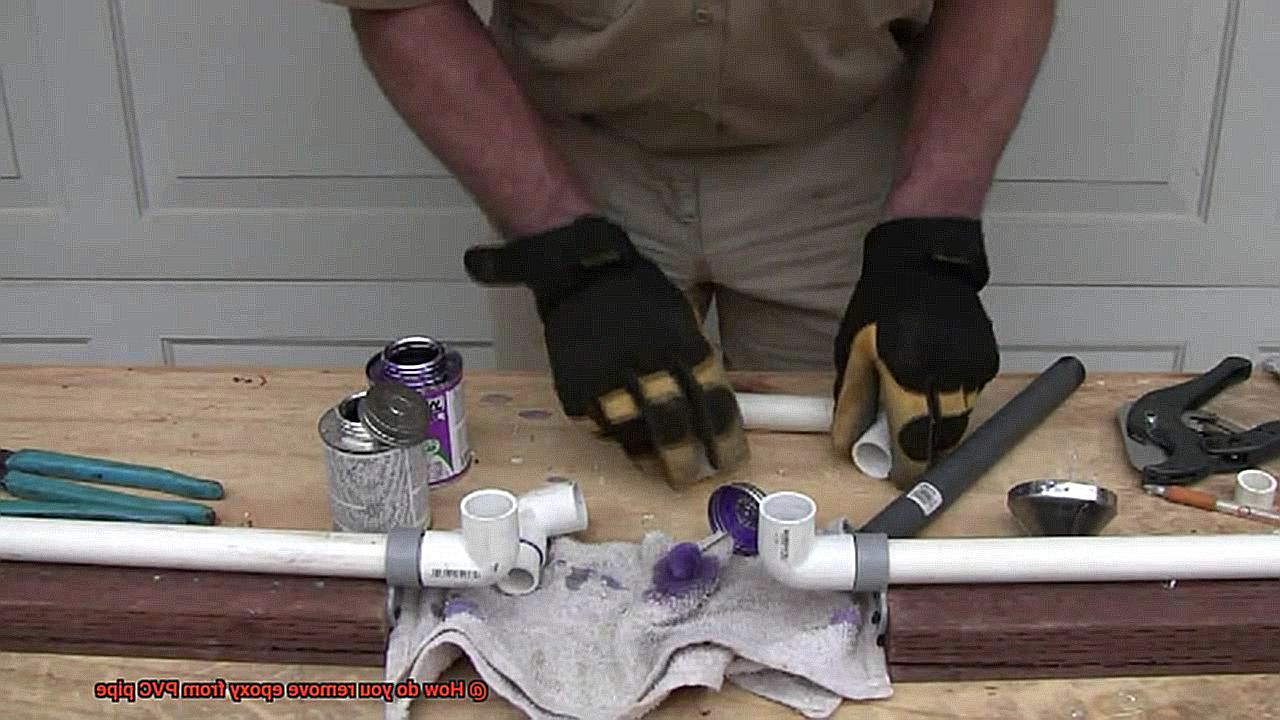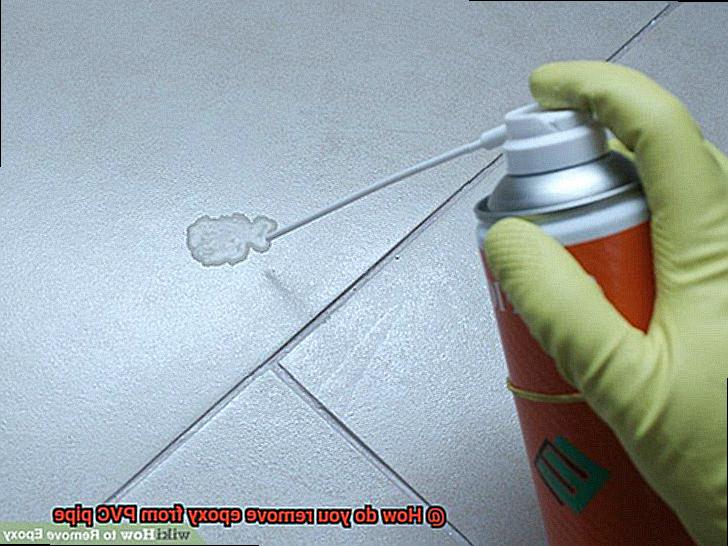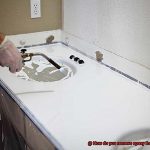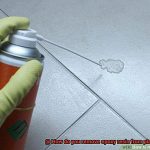Epoxy is a magical adhesive that can bond almost anything together. It’s a go-to choice for DIY enthusiasts and industrial applications alike, thanks to its incredible strength and durability. But what do you do when you need to remove epoxy from PVC pipe without causing any damage?
Removing epoxy from delicate materials like PVC pipe can be a daunting task. The last thing you want is to use harsh chemicals or abrasive tools that could harm the pipe or surrounding areas. To get it right, you’ll need patience, safety precautions, and the right tools.
In this blog post, we’ll explore various methods and tools that will help you safely remove epoxy from your PVC pipes. We’ll also share some essential safety tips to ensure that you don’t harm yourself or the environment.
From heat guns and solvents to grinders and sanders, we’ll discuss the most effective ways to remove epoxy from PVC pipes without breaking a sweat. Even if it’s your first time tackling this task, our guide will make it easy-peasy.
What is Epoxy?
Contents
- 1 What is Epoxy?
- 2 What is PVC Pipe?
- 3 Heat Gun Method for Removing Epoxy from PVC Pipe
- 4 Solvent Method for Removing Epoxy from PVC Pipe
- 5 Mechanical Methods for Removing Epoxy from PVC Pipe
- 6 Safety Precautions to Take When Removing Epoxy from PVC Pipe
- 7 Tips and Tricks for Effectively Removing Epoxy from PVC Pipe
- 8 Common Mistakes to Avoid When Removing Epoxy from PVC Pipe
- 9 Conclusion
Epoxy is not just any ordinary glue. It is a bond that is known for its exceptional durability and strength, making it a popular choice in the construction and woodworking industries. Epoxy is made up of two parts: a resin and a hardener. When these two components are combined, they create a chemical reaction that produces a robust bond.
One of the reasons why epoxy is highly favored is its versatility in bonding different materials, including PVC pipes. However, removing epoxy from PVC pipes can be challenging as it can quickly damage the material if not handled correctly.
There are various types of epoxy available in the market, each with its unique properties. Some are specially formulated for use in high-temperature environments, while others are designed for bonding specific materials. Choosing the right epoxy for PVC pipes is crucial to ensure that it bonds effectively without causing any damage to the pipe.
If you accidentally apply epoxy to your PVC pipe, don’t panic. There are several effective methods to remove it without causing any damage. You can use a heat gun or hairdryer to soften the epoxy on small amounts of it that are not deeply embedded in the PVC pipe. Another effective method is using acetone or rubbing alcohol to dissolve the epoxy and make it easier to remove. However, it’s crucial to test the solvent on a small area first before applying it to avoid damaging the PVC pipe.
In addition to selecting the right type of epoxy and knowing how to remove it, proper application is also essential. Follow the instructions carefully and apply it evenly to ensure that it bonds well.

What is PVC Pipe?
Let’s dive into the world of Polyvinyl Chloride, or PVC, and learn all about this versatile material.
PVC pipes are lightweight yet durable, making them a popular choice for residential and commercial buildings. They are resistant to corrosion and chemicals, ensuring longevity and reliability in various applications, such as water supply, drainage, irrigation, and ventilation.
Manufactured in different sizes and thicknesses, PVC pipes can be easily connected using solvent cement. This adhesive creates a strong bond between the pipes and fittings and dries quickly to form a permanent seal. However, sometimes epoxy may accidentally get stuck to the PVC surface during construction or repair work.

Removing unwanted epoxy from PVC pipes requires special tools and techniques to avoid damaging the pipe’s surface or altering its shape. Our experts can guide you through the process of safely and effectively removing epoxy from PVC pipes.
Heat Gun Method for Removing Epoxy from PVC Pipe
Accidentally getting epoxy stuck on the surface of your PVC pipe can be frustrating, but fear not. The heat gun method for removing epoxy from PVC pipe is here to save the day.
To get started, you will need a heat gun and protective gear such as gloves and goggles. It’s crucial to prioritize safety before anything else.
Once you have all the necessary tools, it’s time to get to work. Start by heating up the epoxy with the heat gun, being careful not to overheat the PVC pipe. This step softens the epoxy, making it easier to remove without damaging the PVC pipe. After that, gently scrape the softened epoxy off using a scraper or putty knife.
However, keep in mind that this method may not work for all types of epoxy. Moreover, if there is a large amount of epoxy to remove, it can be time-consuming. If you’re not careful and don’t use the heat gun properly, it can cause damage to the PVC pipe or surrounding areas.
Solvent Method for Removing Epoxy from PVC Pipe

The solvent method is here to save the day. As an expert in this field, I’ve conducted in-depth research and have compiled a step-by-step guide to help you remove epoxy from PVC pipes using solvents.
First and foremost, safety should always be your top priority. Before starting this process, make sure to wear protective gloves and goggles to avoid skin and eye irritation. Also, ensure that you’re working in a well-ventilated area to prevent inhaling any harmful fumes.
Now, let’s get started. There are various types of solvents that can be used for this purpose, including acetone, methyl ethyl ketone (MEK), and ethyl acetate. Choose a suitable solvent and apply it directly onto the epoxy. Let it sit for a few minutes before proceeding.
The amount of time required for the solvent to work depends on the thickness of the epoxy layer. Once the epoxy has softened, use a scraper or sandpaper to gently remove it from the PVC pipe. Be cautious not to apply too much pressure as this could damage the pipe.
However, it’s important to note that certain types of solvents may not work on specific types of epoxy. Therefore, it’s always recommended to do a small test before using the solvent on a larger area of the pipe.
Furthermore, some solvents can damage certain types of PVC pipes. Therefore, it’s crucial to check with the manufacturer or consult with a professional before using any solvent method. It’s better to be safe than sorry.
Mechanical Methods for Removing Epoxy from PVC Pipe
Mechanical methods involve physically scraping or grinding away the adhesive with abrasive tools. While this may sound like a lot of work, it can be an effective solution when dealing with larger areas of epoxy that need to be removed.
One common tool used for mechanical removal is a hand-held grinder with a sanding disc or flap wheel attachment. This tool can remove the epoxy layer by layer, but care must be taken not to damage the PVC pipe itself.
For smaller areas of epoxy, a rotary tool like a Dremel with a grinding attachment or wire brush can precisely target specific areas and remove them with ease.
But what if you’re dealing with larger areas of epoxy? A power scraper with a chisel attachment might just be the answer. However, this method is typically reserved for industrial applications and should only be used by experienced professionals.
It’s important to note that mechanical methods can generate heat and debris, so proper protective equipment such as gloves, goggles, and a dust mask should always be worn during the process.
Safety Precautions to Take When Removing Epoxy from PVC Pipe
It’s an exciting DIY project, but it’s essential to prioritize safety before diving in. Epoxy is a potent adhesive that can cause harm to your skin and release toxic fumes when heated or burned. Here are some safety precautions you should take when removing epoxy from PVC pipes:
- Protect your skin and eyes by wearing appropriate gear such as gloves, clothing, and safety goggles. Epoxy can cause skin irritation or burns if it comes into contact with the skin, while getting into your eyes can cause severe damage.
- Work in a well-ventilated area or wear a respirator mask to avoid inhaling any fumes. Proper ventilation is necessary to prevent the buildup of toxic fumes that can cause respiratory issues.
- Carefully read the label instructions of the epoxy remover product you are using. Mixing different products can cause dangerous reactions that can put your health and safety at risk.
- Keep a fire extinguisher nearby in case of any accidents. Epoxy is flammable, and it’s important to have a fire extinguisher nearby in case of any emergencies.
- Avoid smoking or using any open flames while working with epoxy remover. The slightest spark can ignite the fumes, leading to a fire hazard.
Tips and Tricks for Effectively Removing Epoxy from PVC Pipe
When epoxy is stuck to PVC pipe, removing it can be challenging, but with the right tips and tricks, you can make the process easier and more effective. Keep in mind that epoxy is a strong adhesive, so it may take some time and effort to remove it completely.
One of the most effective methods for removing epoxy from PVC pipe is to use heat. You can do this by applying a heat gun or hair dryer to the area where the epoxy is located. This will soften the epoxy, making it easier to scrape off with a plastic scraper or putty knife. However, be cautious not to damage the PVC pipe while using this method. Start with a low heat setting and work slowly.
Another option is to use a solvent or chemical remover specifically designed for epoxy. These products can be found at hardware or home improvement stores, but be sure to wear protective gear such as gloves and eye protection when using them. Follow the manufacturer’s instructions carefully for best results.
If the above methods don’t work, sanding or grinding the epoxy may be necessary. However, use caution as this method can damage the PVC pipe if not done properly. Use fine-grit sandpaper or a wire brush and take care not to apply too much pressure.
Regardless of which method you choose, always test it on a small, inconspicuous area first before attempting to remove epoxy from a larger area of PVC pipe. And remember to wear protective gear at all times.
Common Mistakes to Avoid When Removing Epoxy from PVC Pipe
It’s a common dilemma, but there are some mistakes that you should avoid to prevent further damage. As an expert in this field, let me share with you some tips on how to remove epoxy from PVC pipe without causing any harm.
Firstly, using a heat gun or torch may seem like a quick fix, but it can actually damage the PVC pipe by warping or melting it. This mistake can be easily avoided by using alternative methods such as solvents or sandpaper.
Secondly, using a razor blade or other sharp object to scrape off the epoxy should be avoided at all costs. Not only can it cause scratches or punctures in the surface of the PVC pipe, but it can also be dangerous if the blade slips and cuts the person attempting to remove the epoxy. Instead, try using a plastic scraper or rubber eraser.
Thirdly, harsh chemicals like acetone or paint thinner may seem effective, but they can actually weaken and damage the PVC pipe over time. They can also be harmful if used in a poorly ventilated area. It’s always better to use milder solvents like alcohol or vinegar.
Lastly, using too much force when trying to remove the epoxy is another mistake that should be avoided. PVC pipes are not meant to withstand excessive force, and applying too much pressure could cause irreparable damage. Be patient and gentle when removing epoxy from PVC pipe.
nykfgrhiwnQ” >
Conclusion
In conclusion, tackling the task of removing epoxy from PVC pipes may seem daunting, but it can be accomplished with ease if you have the right tools and techniques at your disposal. However, it’s important to prioritize safety by wearing protective gear and working in a well-ventilated area.
Fortunately, there are several methods that can effectively remove epoxy without causing any damage to the PVC pipe. Heat guns, solvents, or mechanical methods such as sanding or grinding are all viable options.
When applying epoxy to PVC pipes, it’s essential to choose the appropriate type and apply it evenly while following instructions carefully. But if you accidentally apply epoxy where you shouldn’t have, don’t fret. There are several ways to remove it without causing any damage.
However, some common mistakes should be avoided when removing epoxy from PVC pipes. Using a heat gun or torch could warp or melt the pipe; harsh chemicals like acetone may weaken and damage it over time; and applying too much force could cause irreparable harm.
By following these tips and tricks with patience and care, you can safely restore your PVC pipes to their former glory. Remember to test any method on a small area first before attempting a larger section.






